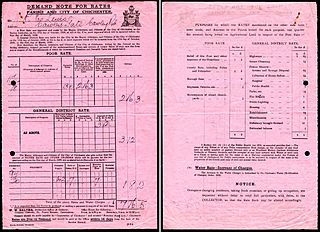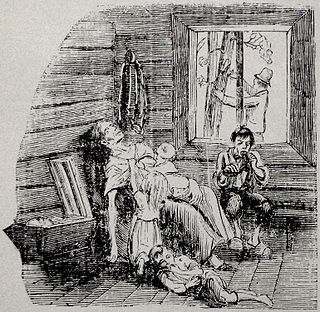Related Research Articles

The English Poor Laws were a system of poor relief in England and Wales that developed out of the codification of late-medieval and Tudor-era laws in 1587–1598. The system continued until the modern welfare state emerged after the Second World War.

In Britain, a workhouse was a total institution where those unable to support themselves were offered accommodation and employment. The earliest known use of the term workhouse is from 1631, in an account by the mayor of Abingdon reporting that "we have erected with'n our borough a workhouse to set poorer people to work".

In England, a civil parish is a type of administrative parish used for local government. It is a territorial designation which is the lowest tier of local government below districts and counties, or their combined form, the unitary authority. Civil parishes can trace their origin to the ancient system of ecclesiastical parishes which historically played a role in both civil and ecclesiastical administration; civil and religious parishes were formally split into two types in the 19th century and are now entirely separate. The unit was devised and rolled out across England in the 1860s.

Agnatic seniority is a patrilineal principle of inheritance where the order of succession to the throne prefers the monarch's younger brother over the monarch's own sons. A monarch's children succeed only after the males of the elder generation have all been exhausted. Agnatic seniority essentially excludes females of the dynasty and their descendants from the succession. Contrast agnatic primogeniture, where the king's sons stand higher in succession than his brothers.

The Highland Potato Famine was a period of 19th century Highland and Scottish history over which the agricultural communities of the Hebrides and the western Scottish Highlands saw their potato crop repeatedly devastated by potato blight. It was part of the wider food crisis facing Northern Europe caused by potato blight during the mid-1840s, whose most famous manifestation is the Great Irish Famine, but compared to its Irish counterpart it was much less extensive and took many fewer lives. The terms on which charitable relief was given, however, led to destitution and malnutrition amongst its recipients. A government enquiry could suggest no short-term solution other than reduction of the population of the area at risk by emigration to Canada or Australia. Highland landlords organised and paid for the emigration of more than 16,000 of their tenants and a significant but unknown number paid for their own passage. Evidence suggests that the majority of Highlanders who permanently left the famine-struck regions emigrated, rather than moving to other parts of Scotland. It is estimated that about a third of the population of the western Scottish Highlands emigrated between 1841 and 1861.

The Poor Law Amendment Act 1834 (PLAA) known widely as the New Poor Law, was an Act of the Parliament of the United Kingdom passed by the Whig government of Earl Grey. It completely replaced earlier legislation based on the Poor Law of 1601 and attempted to fundamentally change the poverty relief system in England and Wales. It resulted from the 1832 Royal Commission into the Operation of the Poor Laws, which included Edwin Chadwick, John Bird Sumner and Nassau William Senior. Chadwick was dissatisfied with the law that resulted from his report. The Act was passed two years after the 1832 Reform Act extended the franchise to middle class men. Some historians have argued that this was a major factor in the PLAA being passed.
In England and Wales, an extra-parochial area, extra-parochial place or extra-parochial district was a geographically defined area considered to be outside any ecclesiastical or civil parish. Anomalies in the parochial system, they had no church or clergymen and were therefore exempt from payment of poor or church rates and usually tithes. They were formed for a variety of reasons, often because an area was unpopulated or unsuitable for agriculture, but also around institutions and buildings or natural resources. Extra-parochial areas caused considerable problems when they became inhabited as they did not provide religious facilities, local governance or provide for the relief of the poor. Their status was often ambiguous and there was demand for extra-parochial areas to operate more like parishes. Following the introduction of the New Poor Law, extra-parochial areas were effectively made civil parishes by the Extra-Parochial Places Act 1857 and were eliminated by the Poor Law Amendment Act 1868. This was achieved either by being integrated with a neighbouring or surrounding parish, or by becoming a separate civil parish if the population was high enough.

The Andover workhouse scandal of the mid-1840s exposed serious defects in the administration of the English 'New Poor Law'. It led to significant changes in its central supervision and to increased parliamentary scrutiny. The scandal began with the revelation in August 1845 that inmates of the workhouse in Andover, Hampshire, England were driven by hunger to eat the marrow and gristle from bones which they were to crush to make fertilizer. The inmates' rations set by the local Poor Law guardians were less than the subsistence diet decreed by the central Poor Law Commission (PLC), and the master of the workhouse was diverting some of the funds, or the rations, for private gain. The guardians were loath to lose the services of the master, despite this and despite allegations of the master's drunkenness on duty and sexual abuse of female inmates. The commission eventually exercised its power to order dismissal of the master, after ordering two enquiries by an assistant-commissioner subject to a conflict of interest; the conduct of the second, more public inquiry drew criticism.

The Poor Relief Act 1601 was an Act of the Parliament of England. The Act for the Relief of the Poor 1601, popularly known as the Elizabethan Poor Law, "43rd Elizabeth" or the Old Poor Law was passed in 1601 and created a poor law system for England and Wales.
An overseer of the poor was an official who administered poor relief such as money, food, and clothing in England and various other countries which derived their law from England such as the United States.
The Workhouse Test Act 1723 also known as the General Act or Knatchbull's Act was poor relief legislation passed by the British government by Sir Edward Knatchbull in 1723. The "workhouse test" was that a person who wanted to receive poor relief had to enter a workhouse and undertake a set amount of work. The test was intended to prevent irresponsible claims on a parish's poor rate.

In English and British history, poor relief refers to government and ecclesiastical action to relieve poverty. Over the centuries, various authorities have needed to decide whose poverty deserves relief and also who should bear the cost of helping the poor. Alongside ever-changing attitudes towards poverty, many methods have been attempted to answer these questions. Since the early 16th century legislation on poverty enacted by the English Parliament, poor relief has developed from being little more than a systematic means of punishment into a complex system of government-funded support and protection, especially following the creation in the 1940s of the welfare state.
The Outdoor Labour Test Order was a piece of policy issued by the Poor Law Commission on 13 April 1842 which allowed the use of outdoor relief to the able-bodied poor. The order was issued after there was some opposition to the Commission's previous order stating that only indoor relief should be used. During times when the manufacturing industries were performing poorly this became impractical - however the Poor Law Amendment Act 1834 had aimed to prevent the use of outdoor relief and replace it with indoor relief.

In England and Wales the poor rate was a tax on property levied in each parish, which was used to provide poor relief. It was collected under both the Old Poor Law and the New Poor Law. It was absorbed into 'general rate' local taxation in the 1920s, and has continuity with the currently existing Council Tax.
From the reign of Elizabeth I until the passage of the Poor Law Amendment Act in 1834 relief of the poor in England was administered on the basis of a Poor Law enacted in 1601. From the start of the nineteenth century the basic concept of providing poor relief was criticised as misguided by leading political economists and in southern agricultural counties the burden of poor-rates was felt to be excessive. Opposition to the Elizabethan Poor Law led to a Royal Commission on poor relief, which recommended that poor relief could not in the short term be abolished; however it should be curtailed, and administered on such terms that none but the desperate would claim it. Relief should only be administered in workhouses, whose inhabitants were to be confined, 'classified' and segregated. The Poor Law Amendment Act allowed these changes to be implemented by a Poor Law Commission largely unaccountable to Parliament. The Act was passed by large majorities in Parliament, but the regime it was intended to bring about was denounced by its critics as (variously) un-Christian, un-English, unconstitutional, and impracticable for the great manufacturing districts of Northern England. The Act itself did not introduce the regime, but introduced a framework by which it might easily be brought in.
Social work has its roots in the attempts of society at large to deal with the problem of poverty and inequality. Social work is intricately linked with the idea of charity work; but must be understood in broader terms. The concept of charity goes back to ancient times, and the practice of providing for the poor has roots in all major world religions.
The Historiography of the Poor Laws can be said to have passed through three distinct phases. Early historiography was concerned with the deficiencies of the Old Poor Law system, later work can be characterized as an early attempt at revisionism before the writings of Mark Blaug present a truly revisionist analysis of the Poor Law system.
Chronic hunger has affected a sizable proportion of the UK's population throughout its history. Following improved economic conditions that followed World War II, hunger was less of a political issue. Yet since the lasting global inflation in the price of food that began in late 2006 and especially since the financial crisis of 2008, hunger again returned to the political agenda. By December 2013, according to a group of doctors and academics writing in the British Medical Journal, hunger in the UK had reached the level of a "public health emergency".
The Board of Guardians for the Relief of the Jewish Poor or, as it is most generally known, the Jewish Board of Guardians, was a charity established by the upper class Jewish community in the East End of London in 1859. The Board sought to provide relief for Jewish immigrants and soon became the central provider of relief for the Jewish poor in London.

The Famine of 1867–1869 was the last famine in Sweden, and the last major naturally caused famine in Europe.
